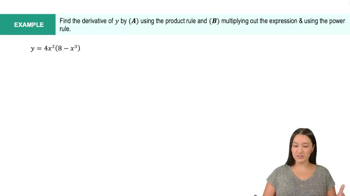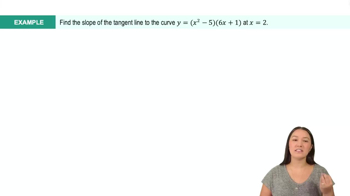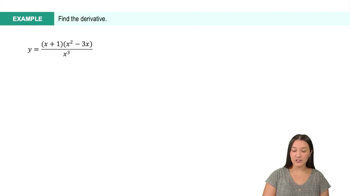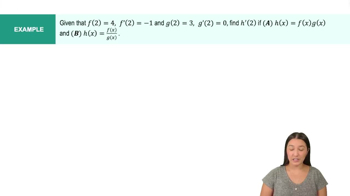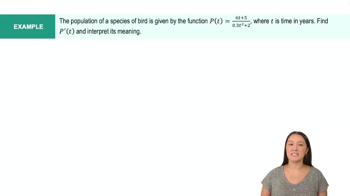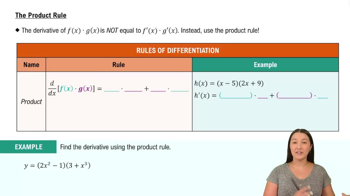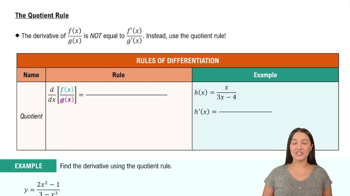Table of contents
- 0. Functions7h 52m
- Introduction to Functions16m
- Piecewise Functions10m
- Properties of Functions9m
- Common Functions1h 8m
- Transformations5m
- Combining Functions27m
- Exponent rules32m
- Exponential Functions28m
- Logarithmic Functions24m
- Properties of Logarithms34m
- Exponential & Logarithmic Equations35m
- Introduction to Trigonometric Functions38m
- Graphs of Trigonometric Functions44m
- Trigonometric Identities47m
- Inverse Trigonometric Functions48m
- 1. Limits and Continuity2h 2m
- 2. Intro to Derivatives1h 33m
- 3. Techniques of Differentiation3h 18m
- 4. Applications of Derivatives2h 38m
- 5. Graphical Applications of Derivatives6h 2m
- 6. Derivatives of Inverse, Exponential, & Logarithmic Functions2h 37m
- 7. Antiderivatives & Indefinite Integrals1h 26m
- 8. Definite Integrals4h 44m
- 9. Graphical Applications of Integrals2h 27m
- 10. Physics Applications of Integrals 2h 22m
3. Techniques of Differentiation
Product and Quotient Rules
Problem 66a
Textbook Question
Population growth Consider the following population functions.
a. Find the instantaneous growth rate of the population, for t≥0.
p(t) = 600 (t²+3/t²+9)
 Verified step by step guidance
Verified step by step guidance1
Step 1: Identify the function for which you need to find the instantaneous growth rate. The function given is \( p(t) = 600 \left( \frac{t^2 + 3}{t^2 + 9} \right) \).
Step 2: To find the instantaneous growth rate, you need to compute the derivative of the function \( p(t) \) with respect to \( t \). This involves using the quotient rule for differentiation.
Step 3: Recall the quotient rule: if you have a function \( \frac{u(t)}{v(t)} \), its derivative is \( \frac{u'(t)v(t) - u(t)v'(t)}{(v(t))^2} \). Here, \( u(t) = t^2 + 3 \) and \( v(t) = t^2 + 9 \).
Step 4: Differentiate \( u(t) \) and \( v(t) \) separately. \( u'(t) = 2t \) and \( v'(t) = 2t \).
Step 5: Apply the quotient rule: \( p'(t) = 600 \left( \frac{(2t)(t^2 + 9) - (t^2 + 3)(2t)}{(t^2 + 9)^2} \right) \). Simplify the expression to find the derivative.
 Verified video answer for a similar problem:
Verified video answer for a similar problem:This video solution was recommended by our tutors as helpful for the problem above
Video duration:
4mPlay a video:
Was this helpful?
Key Concepts
Here are the essential concepts you must grasp in order to answer the question correctly.
Instantaneous Growth Rate
The instantaneous growth rate of a function at a given point is defined as the derivative of that function at that point. In the context of population growth, it represents how fast the population is changing at a specific time, providing insight into trends and future projections.
Recommended video:

Intro To Related Rates
Derivatives
A derivative measures how a function changes as its input changes. In calculus, it is a fundamental tool used to find rates of change, slopes of tangent lines, and to analyze the behavior of functions. For population functions, derivatives help determine growth rates and can indicate whether a population is increasing or decreasing.
Recommended video:

Derivatives
Population Functions
Population functions are mathematical models that describe how a population changes over time. They can take various forms, such as linear, exponential, or polynomial functions. Understanding the specific form of the population function is crucial for applying calculus techniques to analyze growth rates and predict future population sizes.
Recommended video:

Properties of Functions
Related Videos
Related Practice



